#View publisher imprint
Text
BARCELONA OPTIMISTIC ABOUT SIGNING BRAZILIAN GEM
#fc barcelone#Vitor Roque.#This can be linked to multiple factors including the fact that the player himself remains determined to join the club.#Earlier this year#Vitor Roque expressed his desire to play for Barcelona and his entourage will continue to reject advances from other clubs in favour of a m#Without Roque’s help#Barcelona would have exited the pursuit a while ago. But in addition to the player’s desire to join the club#Barça are also seeking to navigate through the Financial Fair Play regulations#which may help them secure the services of the Brazilian.#One of the solutions could see Barça sign the youngster on a loan deal#with an option to buy at the end of the season. Vitor Roque himself believes that Athletico Paranaense will accept this method#and allow the Catalans to pay for the player through instalments.#If the Brazilian outfit had not been open to negotiations#they would have already knocked back Barcelona#given the fact that Vitor Roque has no short of admirers across Europe.#However#it must be noted that Barça desperately need to free up some space in their salary budget before they are able to sign Vitor Roque. This co#with the club notably considering the exit of Ansu Fati.#View publisher imprint#Share this article#RELATED NEWS#Official: Three Barcelona stars called up by Spain national team; Alba#Fati#Ferran miss out#Barca Universal#Barcelona ace happy to have Xavi as manager: “One of the best midfielders in history”#Barcelona were very close to paying €100 million for Serie A striker at one point – report#Barcelona forward has not suffered an injury relapse#but still out for 2-3 weeks#Bayern Munich speedster picks Barcelona winger as the toughest opponent he faced in UCL
0 notes
Text
'I'm in Love with the Villainess' English Audiobook Announced
On Friday, Seven Seas Entertainment announced that it is publishing an audiobook version of Inori's isekai Yuri romance I'm in Love with the Villainess (Watashi no Oshi wa Akuyaku Reijou). The first volume (6 hours and 54 minutes )will be released on November 16, 2023, and the second (10 hours and 45 minutes) on December 7.

Seven Seas is releasing the audiobook under its recently announced audiobook imprint, Siren. It is narrated by voice actress Courtney Shaw (Maesetsu! Opening Act). It will be sold digitally on major platforms, including Audible, audiobook.com, BookWalker, Chrip, Kobo, Overdrive, and Nook.
Seven Seas Entertainment licenses all five volumes of the light novels in English. They follow office worker Oohashi Rei, who wakes up as Rae Taylor, the protagonist of her favorite otome game, Revolution. However, Rae is not interested in any of the game world's eligible bachelors, only having eyes for Claire Francois - the antagonist! And Rae is determined to save Claire from her destined fate.
Inori began publishing the series as a webnovel on Shousetsuka ni Naro in early 2018. GL Bunko licensed the light novels digitally in Japan and published the first volume in 2019. Hanagata draws the illustrations for the light novel. In 2021, Ichijinsha began publishing the light novels in paperback.

I'm in Love with the Villainess gained popularity in several overseas markets, including Korea and America. Critics and audiences praise it for its focus on LGBTQ+ themes, characters, world-building, and story.
A manga adaptation of I'm in Love with the Villainess began serialization in Comic Yuri Hime in June 2020. Ichijinsha publishes six collected volumes of the manga in Japanese. Inori also launched a spin-off, She's so Cheeky for a Commoner (Heimin no Kuse ni Namaikina!), which retells the the series from Claire's point of view. Gl Bunko licensed the spin-off in Japan.
Seven Seas Entertainment licensees both the I'm in Love with the Villainess manga adaptations and the She's so Cheeky for a Commoner spin-off in English. It will release volume five of the manga on October 24 (October 12 digitally) and volume 2 of the spin-off light novel on April 9, 2024.

I'm in Love with the Villainess is also inspiring a television anime adaptation. Hideaki Oba directs the anime at Platinum Vision. It premieres on October 2 and will stream internationally on Crunchyroll.
Source: Press Release, Seven Seas Official Website (release dates)
#yuri#girls love#lgbt#gay#lgbtq#news#anime#manga#light novels#i'm in love with the villainess#ILTV#queer#gl#lesbian
217 notes
·
View notes
Text
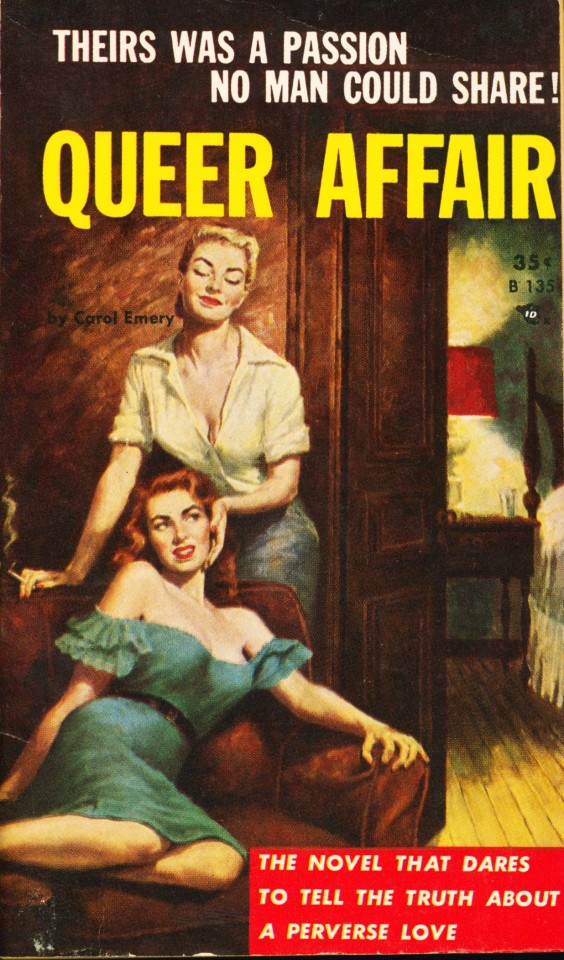



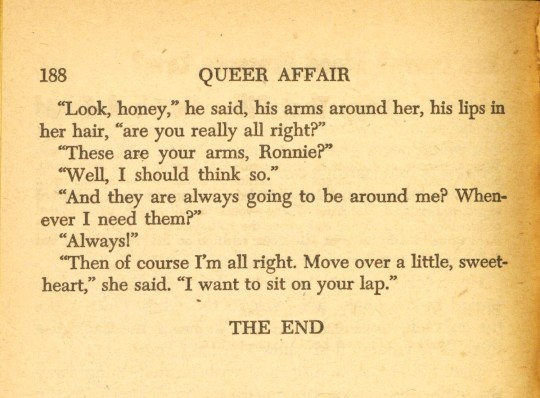
Steamy Saturday
The novel that dares to tell the truth about a perverse love.
Theirs was a love no man could share!
Draga yielded her long-legged girlishness to unnatural embraces. . . . it was an ecstasy such as Draga had never known.
Her lips were tender and clinging as she pressed them to Jo's voluptuous flesh. . . .
She was on the brink of total perversion. . . . Draga's only hope now was -- a man!
Oh, the steaminess of it all!! Carol Emory's pulp novel Queer Affair was published in New York as a Beacon Book, an imprint of Universal Publishing and Distributing Corp., in 1957, and even by today's standards, the sexual frankness of the novel is pretty steamy. Unfortunately, because it's the 1950s, a fully-realized lesbian relationship will not stand. At least one of the partners has to be off her nut (in this case, Jo), while in the end male heroes come to the rescue.
The story centers around up-and-coming dancer Draga Hamilton who is introduced to celebrity sculptor Jo Stanhope by Draga's lawyer Gilbert Young who is desperately in love with Jo. Jo, however, has other ideas, as she seduces the vulnerable Draga and they begin a torrid love affair, which, as already stated, is quite frankly narrated. Draga is head-over-heels, until of course her old flame Ronnie Marsh shows up on the scene and ruins everything for Jo.
In the end, the whole sordid love quadrangle literally devolves into a barely-suppressed S&M encounter. Jo takes her revenge on Draga's infidelity by grabbing a bullwhip that is inexplicably hung on the wall and beats Draga almost senseless with it. The whipping, however, sends both into a building sexual frenzy until both Gilbert and Ronnie come bursting through the door. Ronnie whisks Draga out of harm's way (at least as he perceives it), and Gilbert gives Jo a taste of her own whipping medicine, to which both react with this memorable passage:
Jo Stanhope looked up at him with misted eyes. "Oh, Gilbert -- you've done something for me. You've rescued me. Why, it--it was --" "Never mind," Gilbert said. "And you won't find it so bad being married to me. After all, I'm sort of womanish, you know."
Meanwhile, Draga is recovering in Ronnie's soothing arms, to which she responds, "Move over a little, sweetheart . . . I want to sit in your lap." THE END. Ugh!!
Despite Queer Affair being mentioned in several texts on early lesbian pulp novels, we could find nothing on the author Carol Emory, who we suspect is possibly a man. Nevertheless, the author makes sure early on that the reader knows Emery has done their homework on lesbianism:
Gilbert had warned her that the sculptress was a lesbian, but at the time the fact had seemed to her irrelevant. Love between women was not altogether a new and startling idea to Draga. She had read many books on the subject, including those by Radclyffe Hall and Diana Fredericks.
Appropriately, Barbara Grier, in her iconic The Lesbian in Literature, gives Queer Affair a rating of A for having "a major lesbian component but not sympathetically portrayed." While we may not know who Carol Emory is, we do know that the butch/femme cover art is by Frank Uppwall and was first painted for another pulp novel, Gutter Star by Dorine B. Clark, published in 1954, and then reissued for the cover of Queer Affair three years later.
View more posts on lesbian romance fiction.
View more LGBTQ+ posts.
View other pulp fiction posts.
#Steamy Saturday#pulp fiction#romance novels#romance fiction#lesbians#lesbian romance fiction#lesbian romance novels#lesbian pulp fiction#LGBTQ+#Carol Emery#Queer Affair#Beacon Books#Beacon Book#Universal Publishing and Distributing Corp.#Frank Uppwall#cover art#cover painting#homosexuality#UWM LGBT Collection
55 notes
·
View notes
Text

Kuwabara Mizuna of Mirage of Blaze fame saying recently on twitter that Cobalt (the teen girl light novel magazine/imprint of Shueisha) received a bunch of male editors from Playboy in the 90s, and at first the editors were all confused because they'd never worked with this type of publishing before, but ultimately this experience was good for the writers because the male editors brought a different world view which was very stimulating, and also she believes because they came from Playboy, they let the writers try new things as long as this new thing seemed like it'd be fun.
#thoughts on manga#in a roundabout way#text post#mostly interesting to me in the light of discussion i've seen about male editors for shojo media being awful by default#which again i don't think so
16 notes
·
View notes
Text
September General Imprint Releases: Three New Titles from Duck Prints Press

We’ve got three new short stories out September 28th 2023!
-
Title: A Ghost for Halloween
Author: K. B. Vimes
General/No Relationship, Family and Siblings, Ghosts, Mourning and Grief, Child Point of View
In the spirit of Color by Owl Outerbridge, The Offered Ones by A. L. Heard, and The Fairy Garden by Rhosyn Goodfellow, K. B. Vimes continues our authors’ tradition of writing compelling stories that explore the fears and hopes attendant with raising children in the modern world.
Halloween is Maggie’s favorite day of the year; she just wishes she knew why her parents hate it so much, why they always refuse to go trick-or-treating with her, why her mother spends the night drunk. At least this year, she’s found another kid to go with her. He’s strange, but Maggie will overlook a lot if it means she gets to have a friend.
-
Title: Be Not Afraid
Author: Nicola Kapron
M/M, Angels and Demons and the Apocalypse Oh My!, the Hardest Part of the Post-Apocalypse is Finding a Job, There’s Only One Bed (but the Roommate Doesn’t Sleep)
Nicola Kapron returns with her seventh story published with Duck Prints Press, this time exploring how “the end of the world” can mean very different things depending on one’s circumstances.
Tora survives the end of the world, and so does his sister, even though he can’t escape the niggling feeling that one or both of them shouldn’t have. Still, that’s not his immediately problem. No, he’s more concerned about his demon roommate and his odd-job daily gig.
-
Title: Commute
Author: Eliot Lovell
F/F, the Inherent Awkwardness of Sitting Together on the Train, WLW Disaster Flirting
Fluffy f/f is one of our most popular short story genres. Eliot Lovell’s debut story with Duck Prints Press joins our extensive catalog of works by such authors as A. L. Heard, Violet J. Hayes, Annabeth Lynch, and D. V. Morse. You can check out all of our f/f general imprint titles here.
Eloise intensely dislikes when she has to work in the city, not least because of the commute by train. But the longer the beautiful woman sits across from her in the facing row of seats, the more she starts to think maybe commuting isn’t so bad…
-
Also Now Available: The Summer 2023 General Imprint Bundle!

The Summer 2023 General Imprint Bundle Includes:
Little Witch’s Apothecary by J. D. Harlock
Chinaski’s Dirty Work by J. D. Harlock
Count the Number of Seeds by Lyn Weaver
Entanglement by Lyn Weaver
Awkward and Oblivious by R. L. Houck
if it’s meant to be by Tris Lawrence
Chrysopoeia by Zel Howland
Usually $9.93, you can now get all seven of these stories for only $7.99! Come on over and check out a selection of what Duck Prints Press has to offer!
#duck prints press#new release#our titles#queer stories#eliot lovell#nicola kapron#k. b. vimes#j. d. harlock#lyn weaver#r. l. houck#tris lawrence#zel howland
15 notes
·
View notes
Text

Surprising facts and beliefs about eclipses from the medieval and Renaissance eras
In medieval and Renaissance society and culture, celestial events were not mere spectacles in the sky. Rather, they were omens, predictors of the future, and windows into the workings of the universe.
University of Rochester historian Laura Ackerman Smoller and librarian Anna Siebach-Larsen, director of the Rossell Hope Robbins Library, shed light on how the people of the (falsely labeled) "Dark Ages" actually understood, interpreted, and experienced eclipses, planetary conjunctions, and other astronomical phenomena.
Eclipses were well understood in medieval Europe—at least mathematically
Forget the idea of flat earthers and the notion that medieval people "were generally stupid, ignorant, and superstitious," says Smoller, a professor of history at Rochester and a fellow of the Medieval Academy of America. Ancient and medieval astronomers "knew quite well how to predict when conjunctions and eclipses were going to happen," she says.
They understood that if the moon was either new or full, and when its path crossed the ecliptic—the sun's path—you had an eclipse (a solar eclipse with the new moon and a lunar eclipse with the full moon). During an eclipse, the sun and moon are either in opposition (180 degrees opposite each other) or in conjunction in the exact same degree. But their paths have to be on the exact same plane and need to have crossed, explains Smoller. "That's mathematically pretty sophisticated to conceive," she says.
That said, medieval Europe still held a strictly Earth-centric view that considered the sun and the moon to be planets that orbit Earth—along with the five then-known planets Venus, Mercury, Mars, Jupiter, and Saturn. This geocentric model was not just specific to the Middle Ages—indeed, it was the predominant model in several classical civilizations, including ancient Greece and Rome.
In 1543, the publication De revolutionibus orbium coelestium (On the Revolutions of the Heavenly Spheres) by Renaissance astronomer and mathematician Nicholas Copernicus would kick off the Copernican Revolution. His work ultimately led to the long-held Earth-centric's model being replaced with a heliocentric one that has the sun at the center of our solar system.
Celestial events like eclipses were used to predict the future, including the weather
Medieval Europeans saw alignments of planets, like conjunctions of Jupiter and Saturn, as signs of things to come—from famines, earthquakes, and floods, to the birth of Christ, and even the ultimate collapse of empires. They believed that eclipses, especially solar eclipses, could amplify and strengthen the effects of these planetary conjunctions.
The University's Department of Rare Books, Special Collections, and Preservation (RBSCP) is home to an early printed book from 1485 by Firmin de Beauval titled Opusculum repertorii prognosticon in mutationes aeris (On Predicting Changes in the Weather), published by Erhard Ratdolt, who specialized in printing works of geometry, astrology, and astronomy.
A compilation of ancient medieval sources, the treatise deals with the influence of planets on meteorological phenomena and weather forecasting. But it also covers solstices and equinoxes, planetary conjunctions, and eclipses—and their reported ability to prognosticate the future.
Reading the original imprint (or incunable) in Latin, Smoller notes that eclipses were considered to boost the effects of planetary conjunctions. According to the text, when a solar eclipse is combined with the planetary conjunction of Saturn and Jupiter in the head of Aries, "the effects will last 12,000 years." That staggering number is not a typo. Smoller points to faded marks in the right margins that an early reader, likewise astonished at the described super-booster effect, made in the same passage.
Smoller pushes back against the conventional notion of the superstitious Middle Ages. "I don't think it's superstitious on their part to believe that things that happen in the heavens have an effect on Earth," she says, pointing to the example of tidal changes that are synched with the moon cycle. "That is the nature of medieval, ancient, and a lot of early modern natural philosophy, including beliefs held by Galileo and Kepler."
Medieval theologians pondered the meaning of the 'miraculous eclipse' that apparently occurred during Jesus's crucifixion
The study of eclipses was, unsurprisingly, essential for specialized astronomers. But it also formed part of a general university education during the Middle Ages, including for theologians.
Take the example of William of Auvergne, the bishop of Paris from 1228 to 1249 and a prominent theology professor at the University of Paris. William is one of many writers to discuss the purported "miraculous eclipse" that occurred at the time of Jesus's Crucifixion.
With the 600-folio De universo, which translates to "On the universe," Williams provides "an extraordinary look at the culture of scientific thought and the ways in which it was transmitted," explained Siebach-Larsen after the University acquired a rare copy. The manuscript boasts an unusual illumination that is broken into four elements: earth (complete with mountains and trees), water (with fish), air (with flies), and fire.
An early witness to the idea of "natural magic" among medieval thinkers, William covers the topic of eclipses in De universo. He counts among the many Christian writers, beginning with the earliest Church fathers, to insist that the eclipse at the time of the Crucifixion had to have been miraculous, as it was not naturally possible, says Smoller. Why? Timing is everything: The Crucifixion reportedly took place during Passover, which begins on the first or second full moon after the spring equinox. But you need a new moon—not a full moon—for a solar eclipse to occur.
Doctors in the Middle Ages needed to know about eclipses, too
The Robbins Library collection boasts a beautiful "bat book almanac" that is based on the Kalendarium of John Somer from the 1390s. Small and dainty, the vellum almanac was designed to be folded and carried around. As tools for astronomy, prayer, and astrology, such almanacs played a role in a patient's prognosis, diagnosis, and treatment—the medieval equivalent of a WebMD smartphone app.
"While we see that kind of information in book format frequently, it's very rare to have this kind of manuscript that was made to attach to someone's belt so that they could look at it and unfold it while consulting with someone," says Siebach-Larsen. In fact, there are 31 known almanacs of this type from England in existence, with only four of them—one being the University's—dating as early as the 14th century. According to Siebach-Larsen, the Rochester manuscript might be one of the earliest English manuscripts of these texts and of this type.
Smoller adds that the almanac was designed to let physicians look up the most auspicious time to mix medicines and undertake medical interventions. And while the manuscript contains information about solar eclipses—along with striking illustrations—it's not clear if that particular celestial phenomenon was considered a good or bad omen in the medieval healing arts and sciences.
Lunar and solar eclipses were noteworthy in the Middle Ages. But some planetary alignments were the really big thing.
In a hierarchy of astronomical importance, what comes first—lunar eclipses, solar eclipses, or planetary alignments or conjunctions?
For medieval people, even though eclipses are much more visible, other planetary conjunctions were much more meaningful. That's because for medieval astrologers and astronomers, the sun and the moon are fundamentally two of the seven planets. And according to Smoller, it's the "slower, outer" planets—Saturn, Jupiter, and Mars—that were considered more significant.
"The really important ones are those special conjunctions of Saturn and Jupiter that occur roughly every 240 and 960 years, definitely not those of the every-20-year variety," she says.
While the next Saturn and Jupiter conjunction will take place in 2040, to medieval astronomers that one wouldn't have been very important. Instead, the next particularly significant planetary conjunction—from a medieval perspective—wouldn't be until the 22nd century.
Either way, if history is any indication, it stands to reason that future denizens of our blue planet will continue humanity's enduring fascination with cosmic happenings.
IMAGE....The first page of De universo features a remarkably detailed illumination depicting the four elements of nature (from right): earth, water (note the pair of fish), air (complete with flies), and fire. Credit: University of Rochester photo / J. Adam Fenster
6 notes
·
View notes
Text
Exclusive Cover Reveal: The Forest Demands its Due by Kosoko Jackson
Today on the site I’m delighted to reveal the cover of Kosoko Jackson’s The Forest Demands its Due, a paranormal thriller releasing October 3rd from Quill Tree, an imprint of The Publisher That Needs To Come to the Table and Talk to Its Union Already. For more on the HCP Union and how you can help support its efforts, click here. I also encourage you to use the Bookshop preorder link below, which…
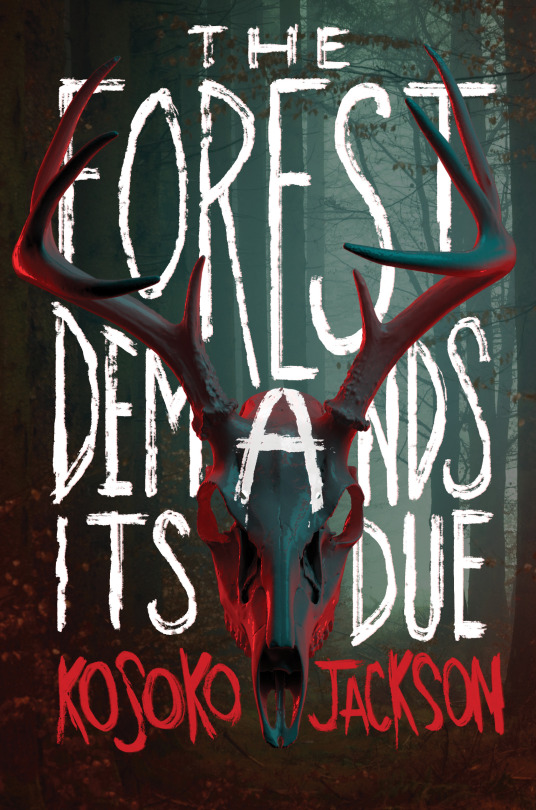
View On WordPress
#Joel Tippie#Kosoko Jackson#QTBIPoC#Quill Tree#Support the Union#The Forest Demands its Due#Thriller#WTF is Wrong With HarperCollins#YA
30 notes
·
View notes
Text
Sweet Tooth's final season's trailer revealed
Sweet Tooth's final season's trailer revealed #sweettooth #netflix
From executive producers Robert Downey Jr. and Susan Downey comes the epic conclusion of the beloved, award-winning series Sweet Tooth.
Sweet Tooth is based on the comic series that was published by DC under their Vertigo imprint and created by Jeff Lemire. It was launched in 2009 and ran for 40 issues wrapping up in 2013.
Experience the final season June 6, only on Netflix

View On WordPress
2 notes
·
View notes
Text
The Haruhi Suzumiya Franchise Is Getting a New Light Novel Volume
The live-streamed “Sneaker Bunko 35th Anniversary Festa!” special has announced that a new volume in Nagaru Tanigawa’s Haruhi Suzumiya light novel series is in production.
Tanigawa and Ito published 11 novels for the original series between 2003-2011. The light novel series has more than 20 million copies in print as of 2017. The Little, Brown Books for Young Readers imprint and Yen Press…

View On WordPress
5 notes
·
View notes
Text

@nancewheelr said : what if nancy smooches wednesday anyway huh what THEN

in ordinary settings, people do not usually go for a kiss unless some imminent danger lurks right behind a corner... or that's what wednesday would like to think. the last time she kissed another in a non - dangerous setting, she had been plagued by a macabre vision showing her exactly who she was kissing : the enemy.
this time however, wednesday was sitting beside nancy, showing her one of her drafts for what will most likely turn out to be another failed attempt at publishing her novels. trust was offered on a silver platter, this particular time, with no strings attached. she did not expect nancy to give her something in return. in other words, she was willingly letting nancy know about her achillies heel. in that very moment, wednesday did no longer hold the upper hand, she was revealing her weaknesses. the contents of her novel just a sick anecdote to how she perceives the world around her and that ultimately included nancy wheeler.
her index finger was skimming through one of the pages as she muttered some of the paragraphs. this passage she was uttering was about viper realizing her acquaintance with jessie might be more than just a mere connection bound to be lost in time. viper did not want to be helped and, consequently, saved from her birthright : dying. alas, jessie had left an imprint on viper's heart which changed the way she viewed the world. viper no longer awaited her demise, she was fighting against it. because she finally had someone to live for.
it was perhaps wednesday's mistake when she kept looking back at nancy whenever she ended up reading one of the paragraphs ; but she was looking for a genuine reaction, to see if she did write a cliche that will be turned down by the editors. instead, nancy pulled wednesday in a kiss. admittedly a tad surprised, wednesday kept her woeful gaze wide open for a brief moment, trying to process what was happening. what shit did viper get herself into? dark lashes batted shut whilst one hand moves to cup nancy's neck, pulling her deeper into the kiss for just a couple more fleeting moments.
and when she finally pulled away, all the words that manage to pass that foul mouth of hers were, ❝ so what do you think about this draft? ❞
#aight i can take a hint when i see one#this is now a thread#nancewheelr#listen she's not the brightest bc nancy and jessie have a similar vibe#and i thought it would be iconic for them to kiss just randomly nothing too fancy#thank u for the smooch nance now live with the consequences bc wednesday would rather die than talk about what just happened
4 notes
·
View notes
Text



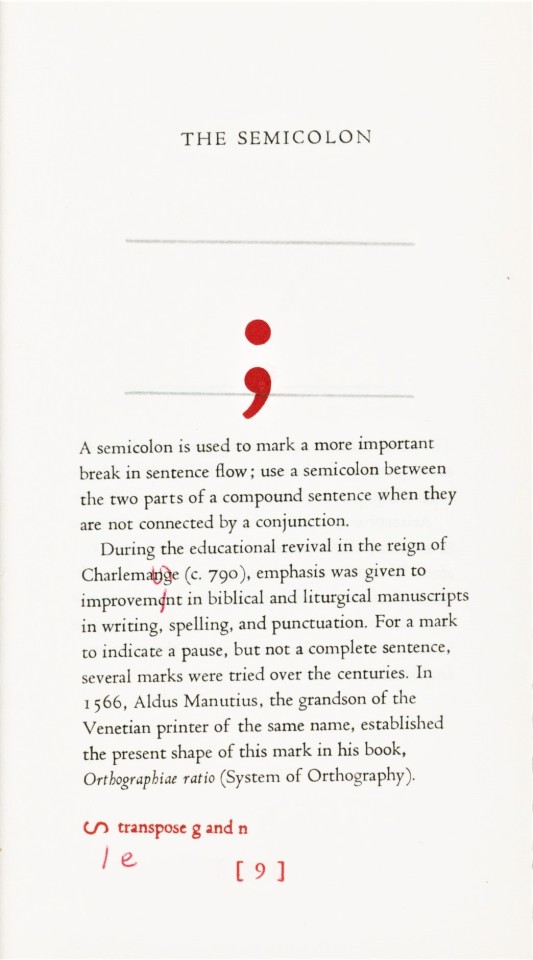

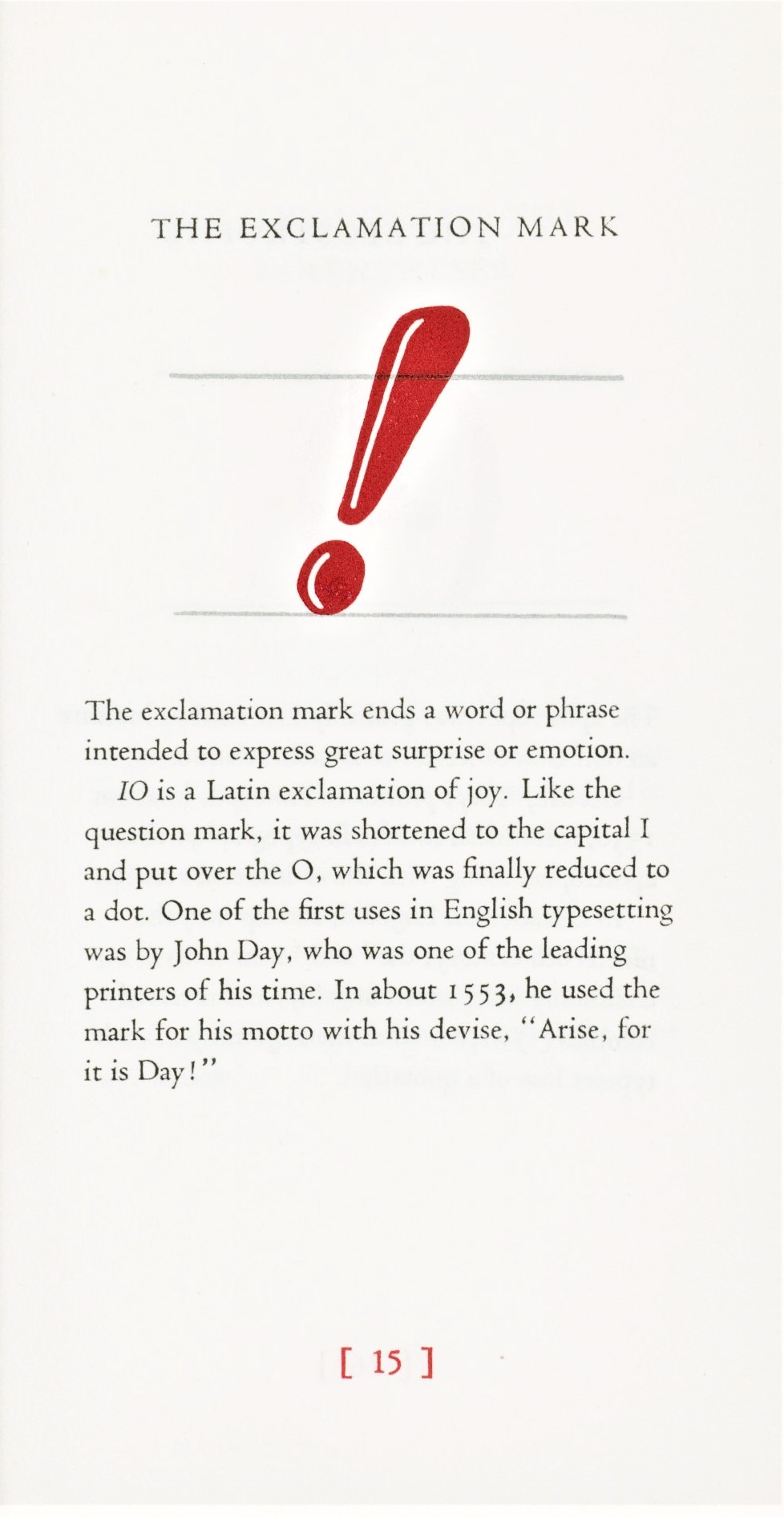

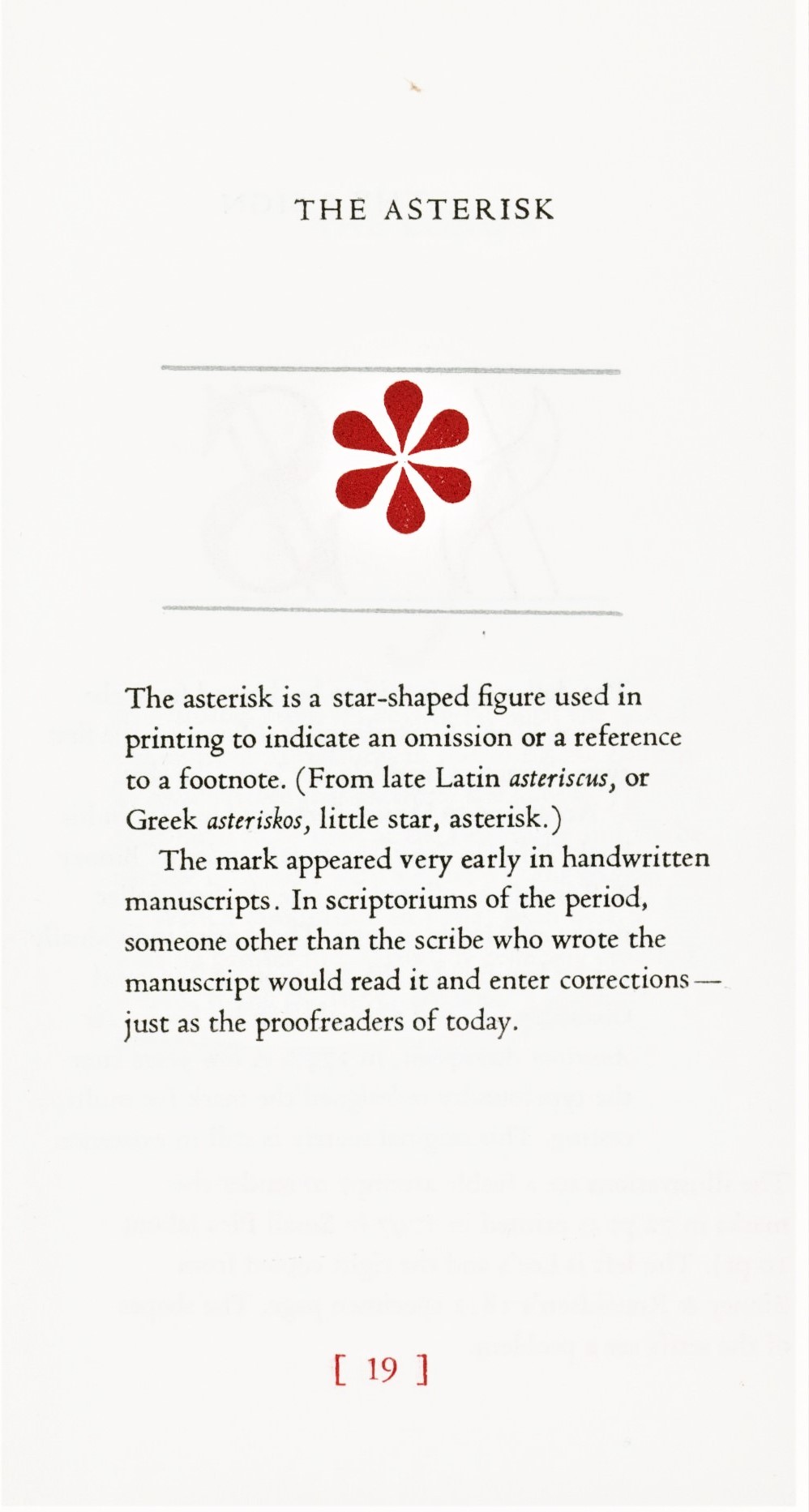



Typography Tuesday
Born in 1923, and after a career as a textbook publisher and graphic designer, Chicago-based printer Muriel Underwood came late to book making and letterpress printing in 1990. In 1995, she printed this little book, A Little Bit About Punctuation and Other Funny Marks, in Chicago under her Miscellaneous Graphics imprint in a limited edition of 90 copies signed by the printer.
She began research on punctuation in 1979 at the Newberry Library and continued intermittently there and in Special Collections at the Chicago Public Library, now the Harold Washington Library. Printing for this book began in the Type Shop of the School of the Art Institute of Chicago, which she had attended after her discharge from the Marines in 1946, and finished in a friend's basement, using a Chandler & Price treadle press at each place. The typeface is 10 pt. Centaur with illustrations in "large metal type adn cuts made from art from numerous sources."
Our copy is a donation from the estate of our late friend, printer and collector Dennis Bayuzick.


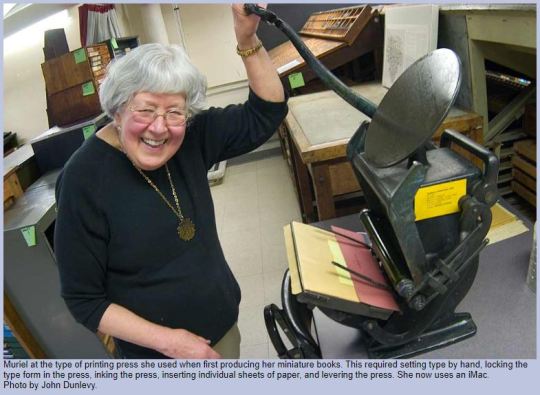
Now this is a joyful printer!!
View other books from the collection of Dennis Bayuzick.
View more Typography Tuesday posts.
#Typography Tuesday#typetuesday#punctuation#Muriel Underwood#A Little Bit About Punctuation and Other Funny Marks#Miscellaneous Graphics#Centaur type#Dennis Bayuzick
128 notes
·
View notes
Text

Providence! I'm having an exhibit and I'm coming to your city for a quick visit this week. It would be great to meet you at Paper Nautilus on Thursday night. Jan 19, 2023, 6-8 PM!
Protest Grim Reapers
Archival Press Photos from Public Collectors
On view Jan 19 – Feb 28, 2023
Reception Jan 19, 6-8pm
Paper Nautilus Books, Wayland Square
19 South Angell Street, Providence, RI, 02906
The Public Collectors project Protest Grim Reapers is a dive into the world of discarded and resold press photo archives. This exhibit reproduces details from 27 press photos of the famed Pale Horse rider, spanning from the late 1960s to the early 1990s. Across six of New England’s coldest weeks, we’ll get cozy with the documented personification of death in a neighborhood bookshop.
From the back cover of the book that accompanies this collection:
The grim reaper is an enduring figure at demonstrations. The reaper—or sometimes simply an angel of death—appears at protests for any cause where the gravity of a death figure feels appropriate. The reaper traditionally carries a scythe and wears a black hood and a skull mask or skull face paint, but sometimes the scythe is replaced with a different symbolic object.
For the past four years I have been collecting press photos of grim reapers at protests against hunger, radioactive waste, animal abuse, the death penalty, the Vietnam war, the closing of a Chrysler plant, demands for clean air and water, restrictions on abortion and more. These older press photos are routinely sold on the secondary market by dealers that acquire the archives of newspapers, or others that have purged their file copies. The dates of these photos reflect the availability of darkroom prints and wirephotos, taken before digital photography became dominant at most news outlets.
In recent years, the grim reaper has been in the news when people wearing this costume attended protests against keeping beaches and schools open during the COVID-19 pandemic. In general, the reaper tells spectators: ‘I am here because this is a matter or life or death for someone or something. I don’t want to be here, but because of you, your corporation, your politicians, or your crimes against humanity, my presence is justified. If this wasn’t deadly serious, I would have stayed at home or worn something else.’
— Marc Fischer / Public Collectors
Marc Fischer is the administrator of Public Collectors, an initiative he formed in 2007. Public Collectors aims to encourage greater access and scholarship for marginal cultural materials, particularly those that museums ignore. Public Collectors’ work includes the Library Excavations publication series and web project, Quaranzine—which produced 100 single page publications with over 75 collaborators at the start of the COVID-19 pandemic, and Malachi Ritscher—a project about the late Chicago music documentarian and activist, produced for the 2014 Whitney Biennial. In addition to Public Collectors, Fischer is also a member of the group Temporary Services (founded in 1998) and a partner in its publishing imprint Half Letter Press (ongoing since 2008). He is based in Chicago. www.publiccollectors.org
#Public Collectors#Marc Fischer#Protest Grim Reapers#Public Collectors Exhibitions#Providence#Paper Nautilus
25 notes
·
View notes
Text
Saturday Releases: All-New Stories by Nicola Kapron and Annabeth Lynch!


This week, we’re welcoming in spring with two very nature-oriented tales: one of the forest, grown wild and out of control, and one of the creatures that play amidst the fireflies during a hot summer night.
Dead Man’s Bells by Nicola Kapron
Dark Fantasy, M/NB, Demonic Possession (Voluntary)
The vines were alive. They writhed like snakes as he ran a hand over them. As one, they untangled themselves from the shrouded shape of the spear. A few even dropped off entirely and nudged at his ankles. Underneath, the weapon gleamed with the soft, wet shimmer of fresh growth.
Around it, he could make out the silhouette of something that was almost human. Luminous green eyes. Roots wrapped tightly into the shape of arms, legs, musculature. Foxglove flowers blooming in the hollow of a throat.
A forest demon persisting long after it had been cut down and sanded into a useful shape.
Beautiful, Liam thought. This feeling might be awe. If he didn’t need to keep moving forward, toward it, he would have fallen to his knees.
For a moment, the ringing paused, and the vines slowed in their movements. “I am not dead,” said the voice that wasn’t his own. “You did not kill me. Even like this, you cannot tame me. Raise me, and I will live again.”
Follow Liam as his life intertwines with that of the verdant growth possessing the basement of his family’s manor. Read Dead Man’s Bells now!
-
Away With the Fairies by Annabeth Lynch
Modern with Magic, Siblings and Family, Fae/Fairy Kidnapping (Consensual)
“Why do the lightning bugs only fly up?” I asked Linda.
“Not all of them do. But this kind produces light as they fly. They’re sending signals to the others,” she said, coming to look at the ones I grabbed. “They’re telling each other things with the lights.”
“Like what?”
“Like what kind they are, or if they’re boys or girls, or whether they want to have babies. They talk by flashing. That’s why they blink.”
“What about that one?” I pointed at a fast-moving one. “That one isn’t blinking at all.”
Linda looked at the one I pointed at. She watched it for a long time, waiting for its light to blink off.
It didn’t.
What have Linda and her sister Suzy found amidst the fireflies (spoilers…it might be in the title…)? Read Away With the Fairies and find out!
-
Love works featuring nature spirits, fae, and fairyfolk? These two aren’t the only ones in our catalog! Check out our anthologies Add Magic to Taste, He Bears the Cape of Stars, and She Wears the Midnight Crown, or…
Let the Solstice Come by D. V. Morse (historical with magic, elementals are enslaved by humans, rebellion)
The Fairy Garden by Rhosyn Goodfellow (modern with magic, child point of view, fae and fairyfolk)
A Glimmer of Hope by Nina Waters (modern with magic, m/m, novel-length, angst with a happy ending)
Who we are: Duck Prints Press LLC is an independent publisher based in New York State. Our founding vision is to help fanfiction authors navigate the complex process of bringing their original works from first draft to print, culminating in publishing their work under our imprint. We are particularly dedicated to working with queer authors and publishing stories featuring characters from across the LGBTQIA+ spectrum. Love what we do? Want to make sure you don’t miss the announcement for future giveaways? Sign up for our monthly newsletter and get previews, behind-the-scenes information, coupons, and more!
Want to support the Press, read about us behind-the-scenes, learn about what’s coming down the pipeline, get exclusive teasers, and claim free stories? Back us on Patreon or ko-fi monthly!
#duck prints press#new release#short story#our titles#nicola kapron#m/nb#family feels#annabeth lynch
20 notes
·
View notes
Text
The Black Man in the CIA has completed his last mission
Leutrell “Mike” Osborne (Black Man in the CIA) has passed away.
Leutrell trusted God. That trust brought him through many dangerous and death-defying accomplishments. Many, that to this day must remain Top Secret.
His book, Black Man in the CIA, is edited and published by Gary Revel on the Jongleur Books imprint.
Jongleur Pictures LLC has 2 movies in development adapted from his stories. They…

View On WordPress
2 notes
·
View notes
Text
Give and Receive a Blessing by James R. Coggins
Several years ago, I established Mill Lake Books to help Christian authors get their books published in an affordable way. To date, this imprint has published over 30 books.
One of the most recent is Fullness of Time: Devotionals, Poems, Pictures, and Prayers by Ray Harris. On one level, this is a beautiful coffee table book. On another level, it is a rich spiritual banquet.
The book grew out…

View On WordPress
2 notes
·
View notes
Text
File under #WTF
“Andrews is a former senior U.S soldier and decorated intelligence officer who conducted global counterterrorism operations on behalf of the United States during a 36-year military career. Shortly after returning from an overseas mission, he began to suffer from rare, life-threatening ailments that defied medical explanation. Rather than succumbing, he instead began to experience special, inexplicable abilities such as remote viewing, and his body began to heal, baffling doctors.
As he sought more information about his health, Andrews came across a file compiled for him by his late father. It contained records from a past he did not remember, including documents indicating he was removed from school for weeks every year, from the first through 12th grades. The records also contained a shocker, that he received an honorable discharge from the U.S Air Force and worked in space intelligence communications as a minor. Andrews maintains he has no memory of having served in the U.S Air Force.
Referred to a classified White House National Security Council program, which had been delegated to the Department of Defense, Andrews then met a man who ran the highly classified program, who introduced him to a doctor. The doctor had worked for the CIA and had expertise enabling him to help Andrews start to piece together what has happened to him and others like him. Soon after connecting with the doctor, Andrews says he experienced symptoms associated with the Havana Syndrome, a phenomenon first reported by military personnel working at the U.S. Embassy in Havana, Cuba, in 2016. The syndrome has generated significant media attention in top-tier outlets including 60 Minutes and The New York Times in recent years. An investigation went on to determine that Andrews had been targeted with an advanced energy weapon...”
11 notes
·
View notes